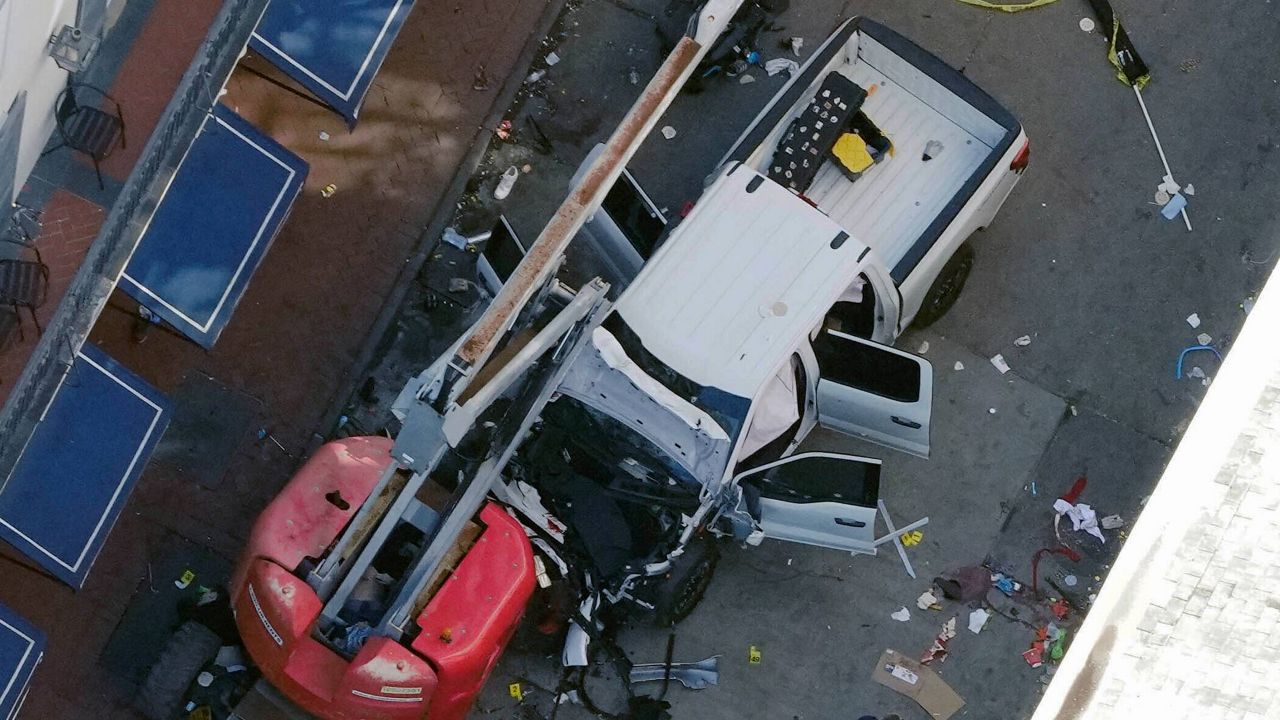NEW ORLEANS — Seven years ago, New Orleans officials began installing adjustable barriers at intersections in the famed French Quarter to temporarily prevent vehicles from entering the tourist area where the narrow streets are typically teeming with pedestrians every night of the week. But the stainless-steel columns known as bollards were in the process of being replaced and some were apparently not engaged early on New Year's Day when a motorist rammed a pickup truck through a crowd of revelers, killing 10 people.
What You Need To Know
- Seven years ago, New Orleans officials began installing adjustable barriers at intersections in the famed French Quarter to temporarily prevent vehicles from entering the tourist area where the narrow streets are typically teeming with pedestrians every night of the week
- But the steel columns known as bollards were in the process of being replaced and some were apparently not engaged early on New Year's Day when a motorist rammed a pickup truck through a crowd of revelers, killing 10 people
- As vehicle attacks have increased globally in recent decades, cities around the world have installed bollards in pedestrian-heavy areas
- They are also a common sight in New York, London, Paris and Tokyo
The project to remove and replace the bollards along about eight blocks of bustling Bourbon Street, from St. Ann Street to Canal Street, began Nov. 18, city documents show. Temporary asphalt patches were installed in the spots where the steel columns were removed, according to the documents.
City officials have not confirmed whether the intersection where the pickup sped through was actively under construction or if the replacement project created a vulnerability.
One day before New Year's Eve, New Orleans officials issued a traffic advisory about its vehicle barrier replacement project, stating that crews would work until 2 p.m. on Monday and try to "minimize road closures as much as possible to reduce impacts" during the celebration.
"Currently, Bourbon Street is fully open from Canal Street to Toulouse Street," the city said in its Dec. 30 advisory.
The intersection of Bourbon and Canal is where the pickup rammed into the mass of people. The driver was shot to death by police and the FBI is investigating the incident as an act of terrorism, authorities said.
As vehicle attacks have increased globally in recent decades, cities around the world have installed bollards in pedestrian-heavy areas. Following the 9/11 attacks, New York City put up similar adjustable steel columns around Times Square, City Hall and Wall Street. They are also a common sight in London, Paris and Tokyo.
Initially installed beginning in Dec. 2017 as part of a $40 million safety plan, the New Orleans' bollards system consists of four sets of barriers placed at either side of Bourbon Street intersections. The inner two columns can be pushed back when unlocked by a ground-level control panel, allowing for a roughly 13-foot berth for vehicles to navigate through, NOLA.com reported when construction began.
Aaron Miller, director of the city's Office of Homeland Security and Emergency Preparedness, said at the time that the bollards would go up nightly in keeping with city rules that close off stretches of the popular French Quarter boulevard exclusively to pedestrians. Otherwise, they would only be used to block intersections either by a city ordinance or during special events, he said.
The barriers were "designed to mitigate against what we believe the risk is for pedestrians" in a part of the city he said was "an iconic or symbolic target," Miller said in Dec. 2017.
There have been proposals over the years to turn much of Bourbon Street into a pedestrian plaza and managed by a team focused on making it safe, Louisiana Lt. Gov. Billy Nungesser said Wednesday. He said it's important to look at every aspect of safety following the New Year's Day carnage.
"You can't prevent something like this when you've got a crazy person that is wanting to cause havoc and take lives," Nungesser told WDSU-TV.
Wednesday's rampage happened amid the ongoing "Bourbon Street Bollard Assessment and Replacement Project."
On Dec. 10, the city posted a photo on social media of a torn-up street in the French Quarter, with two bollards sitting atop a pallet. Work was scheduled to continue through Feb. 2025, when New Orleans will host the Super Bowl, city records show.
"The project includes replacing old bollards with new removable stainless-steel bollards and sidewalk repairs at various locations," a Department of Public Works document states.
In a Nov. 26 update, city officials said work including concrete pouring was occurring on both sides of Bourbon Street "without closing intersections to vehicle traffic."



